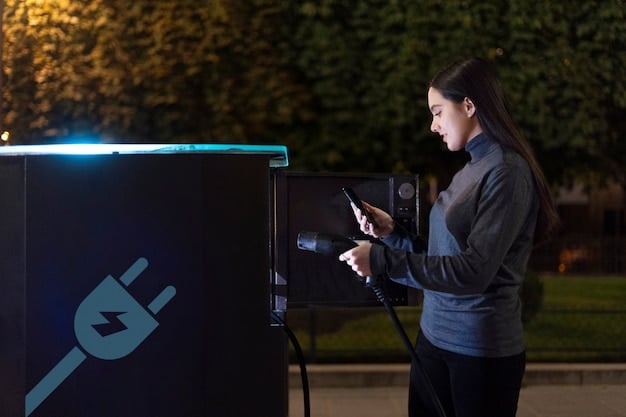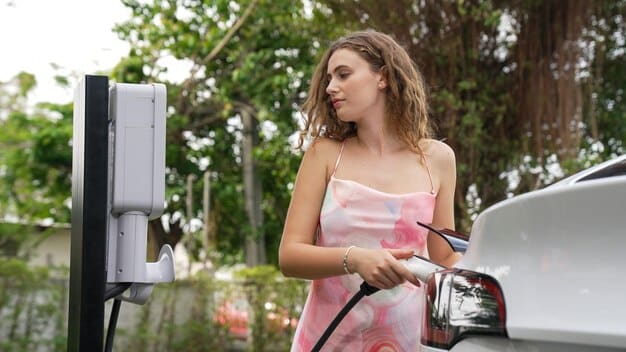Electric Vehicle Tax Credits 2025: New Rules & Eligibility

Navigating the new rules for electric vehicle tax credits in 2025 requires understanding updated income limits, vehicle eligibility criteria, and battery component sourcing to maximize potential savings.
Planning to buy an electric vehicle in 2025? The landscape of federal tax credits for EVs is evolving, and understanding the new rules for electric vehicle tax credits: what you need to know before buying in 2025 is crucial to making an informed decision.
Understanding the Current EV Tax Credit Landscape
The current federal EV tax credit, established under the Inflation Reduction Act, offers up to $7,500 in tax credits for eligible new electric vehicles and fuel cell vehicles. However, several restrictions and requirements govern who can claim the credit and which vehicles qualify.
Key Requirements for Eligibility
To be eligible for the existing EV tax credit, several criteria must be met by both the vehicle and the buyer. These requirements cover the vehicle’s manufacturing location, battery components, and the buyer’s income.
- Vehicle Assembly: The vehicle must be assembled in North America.
- Battery Components: A certain percentage of the battery’s components must be manufactured or assembled in North America.
- Critical Minerals: A percentage of the critical minerals in the battery must be extracted or processed in the United States or a country with a free trade agreement with the U.S.
- Income Limits: Buyers must meet specific modified adjusted gross income (MAGI) thresholds to qualify. These limits are $300,000 for married couples filing jointly, $225,000 for heads of household, and $150,000 for single filers.
Understanding these requirements is pivotal in determining eligibility for the tax credit when purchasing an EV.

In summary, the current EV tax credit structure is complex, with several factors affecting eligibility. Keeping abreast of these requirements is essential for prospective EV buyers.
Anticipated Changes to EV Tax Credits in 2025
Looking ahead to 2025, significant changes are expected in the realm of electric vehicle tax credits. These adjustments aim to refine the incentives, potentially impacting both consumers and manufacturers.
Potential Shifts in Income and Vehicle Eligibility
While the specifics are always subject to change based on legislative updates and regulatory interpretations, several potential changes are being discussed and anticipated for 2025. These include adjustments to income limits and vehicle eligibility criteria.
- Adjusted Income Thresholds: There may be revisions to the MAGI thresholds to better reflect current economic conditions or to target the credit towards specific income brackets.
- Refined Vehicle Requirements: The requirements regarding battery components and critical minerals sourcing could be modified to incentivize domestic manufacturing and ethical sourcing practices.
- Point of Sale Rebates: One significant change being considered is the implementation of point-of-sale rebates, making it easier for buyers to receive the tax credit at the time of purchase.
Keeping abreast of potential changes is crucial for planning an EV purchase in 2025.
In conclusion, the modifications to tax credit eligibility represents a great area of development. Changes based on market variables should be expected to meet target sales.
Impact of Battery Sourcing on Tax Credit Eligibility
One of the most critical factors affecting EV tax credit eligibility is the sourcing of battery components and critical minerals. The Inflation Reduction Act mandates that a certain percentage of these materials must come from North America or countries with free trade agreements with the U.S.
Understanding the Sourcing Requirements
The requirements for battery sourcing are intended to promote domestic manufacturing and reduce reliance on foreign supply chains, particularly those of strategic competitors.
Compliance with these sourcing requirements determines whether a vehicle qualifies for the full tax credit:
- Phased Increases: The percentage requirements for both battery components and critical minerals are being phased in over time, with increases scheduled for 2025 and beyond.
- Manufacturer Challenges: Meeting these requirements poses significant challenges for automakers, who must reconfigure their supply chains to comply.
- Consumer Impact: The impact on consumers is that some vehicles may lose eligibility for the tax credit if manufacturers cannot adjust their sourcing practices in time.
Compliance with these sourcing requirements is challenging, but non-compliance may mean ineligibility for consumer tax credits.

In summary, changes to battery sourcing have wide ranging impact for manufacturers and consumers alike. This is the largest restriction on both parties.
Navigating Income Limitations and Filing Requirements
In addition to vehicle eligibility, individual income also plays a significant role in determining who can claim the EV tax credit. The Inflation Reduction Act implemented income limits to target the credit towards middle- and lower-income taxpayers.
Understanding MAGI Thresholds and Documentation
The modified adjusted gross income (MAGI) thresholds are crucial in determining eligibility. Here’s a breakdown of what you need to know:
- Income Limits: As previously mentioned, the MAGI limits are $300,000 for married couples filing jointly, $225,000 for heads of household, and $150,000 for single filers.
- Filing Requirements: To claim the EV tax credit, you must file Form 8936, Clean Vehicle Credits, with your federal income tax return.
- Documentation: You will need to provide documentation to verify your income and eligibility.
Income verification will be required to assure proper monetary distribution.
In conclusion, income stipulations play a major role in claiming EV tax credits. Proper documentation and filing are important for verification.
Strategies for Maximizing EV Tax Credit Savings in 2025
Given the complexities and potential changes in EV tax credits, it’s essential to adopt effective strategies to maximize potential savings when purchasing an electric vehicle in 2025.
Planning Your EV Purchase for Optimal Savings
Here are some strategies to consider:
- Research Vehicle Eligibility: Stay informed about which vehicles meet the North American assembly and battery sourcing requirements.
- Monitor Legislative Updates: Keep an eye on any potential changes to the tax credit rules and income limits.
- Consider Timing: Depending on your income and the availability of eligible vehicles, consider the timing of your purchase.
- Utilize Point-of-Sale Rebates: If point-of-sale rebates are implemented, take advantage of this option to reduce the upfront cost of the vehicle.
Appropriate research will be required to make the best purchase.
In conclusion, planning your EV purchase thoroughly and strategically can significantly increase your chances of qualifying for the EV tax credit.
Future of EV Incentives and Government Goals
The future of EV incentives is closely tied to broader government goals related to climate change, domestic manufacturing, and energy independence. The EV tax credit is a key tool in achieving these objectives.
Long-Term Vision for Electric Vehicle Adoption
The government’s vision for electric vehicle adoption extends beyond just consumer incentives. It includes investments in charging infrastructure, research and development, and workforce training.
- Infrastructure Development: The Bipartisan Infrastructure Law includes funding for a national network of EV chargers.
- R&D Investments: The Department of Energy is investing in research to improve battery technology and reduce the cost of EVs.
- Workforce Training: Programs are being developed to train workers for jobs in the EV industry.
All this information contributes to a better understanding of EV adoption.
In summary, government goals play an important role in the advancement of EV. There are multiple incentives for the adoption.
| Key Point | Brief Description |
|---|---|
| 💰 Income Limits | MAGI thresholds apply: $300k (married), $225k (head of household), $150k (single). |
| 🔋 Battery Sourcing | Components & minerals must be from North America or free trade partners. |
| 🚗 Vehicle Assembly | Vehicle must be assembled in North America to be eligible. |
| ⏱️ Point of Sale | Potential for rebates at purchase, reducing upfront cost. |
FAQ
▼
The income limits are based on your modified adjusted gross income (MAGI): $300,000 for married couples filing jointly, $225,000 for heads of household, and $150,000 for single filers.
▼
The EV must be assembled in North America to be eligible for the tax credit. Check the VIN of the vehicle to verify the location.
▼
The maximum tax credit amount is $7,500 for eligible new electric vehicles and fuel cell vehicles, subject to meeting certain requirements.
▼
You will need to file Form 8936, Clean Vehicle Credits, with your federal income tax return to claim the EV tax credit.
▼
Used EVs do have their own rules and restrictions which are different from new EVs. The tax credit is a smaller amount and income is considered.
Conclusion
Understanding the landscape of new rules for electric vehicle tax credits: what you need to know before buying in 2025 is crucial for claiming all benefits. By staying informed and planning strategically, you can make the most of the available incentives.





